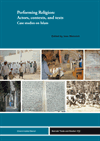Abstract
"Performing Religion" investigates the relationship between texts, actors, and contexts in the study of Islam. Research in Islamic Studies to date has taken texts primarily as a medium of information. This volume emphasizes the material quality of texts, both written and oral. It focuses on the sound and rhythm of their performance, on nonverbal elements, and practices of framing and embedding. "Performing Religion" also looks at the interpretation of religious practices not based on lengthy textual foundations but which nevertheless constitute an important part of believers' lives. The assembled case studies encompass contemporary as well as historic perspectives and include examples from Andalusia, Egypt, Italy, Greater Syria, Turkey, Central Asia, Yemen, Iran, and India.
Part I explores objects, actions, and notions in the context of the acquisition of blessing ("baraka"). Part II asks how believers use, alter, and publically enact texts in ritual settings and what kinds of performance are inscribed into the text. Part III analyses the negotiation of meanings, aesthetics, and identity which occurs in new and often transcultural contexts. Rather than viewing texts as a repository of ideas, the present volume accentuates their ritual functions and the aesthetic experiences they provide.
- 9–10 Preface 9–10
- 245–248 The Authors 245–248
- 249–256 Plates 249–256
- 257–260 Index 257–260

